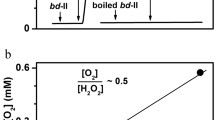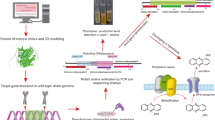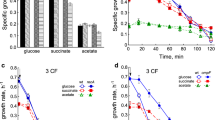Abstract
In cells of Escherichia coli, terminal oxidase bd-I encoded by the cydAB gene catalyzes the reduction of O2 to water using hydroquinone as an electron donor. In addition to the cydAB operon, two other genes, cydC and cydD, encoding the heterodimeric ATP-binding cassette-type transporter are essential for the assembly of cytochrome bd-I. It was shown that inactivation of cytochrome bd-I by the introduction of cydB or cydD deletions into the E. coli chromosome leads to supersensitivity of the bacteria to antibiotics of the quinolone and beta-lactam classes. The sensitivity of these mutants to antibiotics is partially suppressed by introduction of a constitutively expressed gene katG under the control of the Ptet promoter into their genome. The increased level of hydrogen sulfide resulting from the introduction of the mstA gene, encoding 3-mercaptopyruvate sulfurtransferase, under the control of the Ptet promoter, leads to the same effect. These data demonstrate the important role of cytochrome bd-I in the defense of bacteria from oxidative stress and bactericidal antibiotics.






Similar content being viewed by others
REFERENCES
Anraku Y., Gennis R.B. 1987. The aerobic respiratory chain of Escherichia coli. Trends Biochem. Sci. 12, 262–266.
Kranz R.G., Gennis R.B. 1983. Immunological characterization of the cytochrome o terminal oxidase from Escherichia coli. J. Biol. Chem. 258, 10614‒10621.
Rice C.W., Hempfling W.P. 1978. Oxygen-limited continuous culture and respiratory energy conservation in Escherichia coli. J. Bacteriol. 134, 115–124.
Georgiou C.D., Fang H., Gennis R.B. 1987. Identification of the cydC locus required for the expression of the functional form of the cytochrome d terminal oxidase complex in Escherichia coli. J. Bacteriol. 169, 2107–2112.
Poole R.K., Hatch L., Cleeter M.W.J., Gibson F., Cox G.B., Wu G. 1993. Cytochrome bd biosynthesis in Escherichia coli: The sequences of the cydC and cydD genes suggest that they encode the components of an ABC membrane transporter. Mol. Microbiol. 10, 421–430.
Borisov V.B., Forte E., Konstantinov A.A., Poole R.K., Sarti P., Giuffre A. 2004. Interaction of the bacterial terminal oxidase cytochrome bd with nitric oxide. FEBS Lett. 576, 201–204.
Mason M.G., Shepherd M., Nicholls P., Dobbin P.S., Dodsworth K.S., Poole R.K., Cooper C.E. 2009. Cytochrome bd confers nitric oxide resistance to Escherichia coli. Nat. Chem. Biol. 5, 94–96.
Lindqvist A., Membrillo-Hernandez J., Poole R.K., Cook G.M. 2000. Roles of respiratory oxidases in protecting Escherichia coli K12 from oxidative stress. Antonie Van Leuwenhoek. 78, 23–31.
Giuffre A., Borisov V.B., Arese M., Sarti P., Forte E. 2014. Cytochrome bd oxidase and bacterial tolerance to oxidative and nitrosative stress. Biochim. Biophys. Acta. 1837, 1178–1187.
Borisov V.B., Davletshin A.I., Konstantinov A.A. 2010. Peroxidase activity of cytochrome bd from Escherichia coli. Biochemistry (Moscow). 75, 428–436.
Korshunov S., Imlay J.A. 2010. Two sources of endogenous hydrogen peroxide in Escherichia coli. Mol. Microbiol. 75, 1389–1401.
Rice C.W., Hempfling W.P. 1978. Oxygen-limited continuous culture and respiratory energy conservation in Escherichia coli. J. Bacteriol. 134, 115–124.
Cotter P.A., Chepuri V., Gennis R.B., Gunsalus R.P. 1990. Cytochrome o (cyoABCDE) and d (cydAB) oxidase gene expression in Escherichia coli is regulated by oxygen, pH, and the fnr gene product. J. Bacteriol. 172, 6333–6338.
Fu H.-A., Iuchi S., Lin E.C.C. 1991. The requirement of ArcA and Fnr for peak expression of the cyd operon in Escherichia coli under microaerobic conditions. Mol. Gen. Genet. 226, 209–213.
Avetisyan A.V., Bogachev A.V., Murtasina R.A., Skulachev V.P. 1992. Involvement of a d-type oxidase in the Na+-motive respiratory chain of Escherichia coli growing under low ΔμH+ conditions. FEBS Lett. 306, 199–202.
Delaney J.M., Fayet O., Lipinska B., Yamamoto T., Georgopoulos C. 1992. arc-Dependent thermal regulation and extragenic suppression of the Escherichia coli cytochrome d operon. J. Bacteriol. 174, 6554–6562.
Delaney J.M., Wall D., Georgopoulos C. 1993. Molecular characterization of the Escherichia coli htrD gene: cloning, sequence, regulation, and involvement with cytochrome d oxidase. J. Bacteriol. 175, 166–175.
Ashcroft J.R., Haddock B.A. 1975. Synthesis of alternative membrane-bound redox carriers during aerobic growth of Escherichia coli in the presence of potassium cyanide. Biochem. J. 148, 349–352.
Brekasis D., Paget M.S. 2003. A novel sensor of NADH/NAD+ redox poise in Streptomyces coelicolor A3(2). EMBO J. 222, 4856–4865.
Bogachev A.V., Murtazina R.A., Skulachev V.P. 1993. Cytochrome d induction in Escherichia coli growing under unfavorable conditions. FEBS Lett. 336, 75–78.
Bogachev A.V., Murtazine R.A., Shestopalov A.I., Skulachev V.P. 1995. Induction of the Escherichia coli cytochrome d by low ΔμH+ and by sodium ions. Eur. J. Biochem. 232, 304–308.
Tamegai H., Kato C., Horikoshi K. 1998. Pressure-regulated respiratory system in barotolerant bacterium, Shewanella sp. strain DSS12. J. Biochem. Mol. Biol. Biophys. 1, 213–220.
Tamegai H., Kawano H., Ishii A., Chikuma S., Nakasone K., Kato C. 2005. Pressure-regulated biosynthesis of cytochrome bd in piezo- and psychrophilic deep-sea bacterium Shewanella violacea DSS12. Extremophiles. 9, 247–253.
Poole R.K., Williams H.D., Downie J.A., Gibson F. 1989. Mutations affecting the cytochrome d-containing oxidase complex of Escherichia coli K12: identification and map** of a fourth locus, cydD. J. Gen. Microbiol. 135, 865–1874.
Macinga D.R., Rather P.N. 1996. aarD, a Providencia stuartii homologue of cydD: role in 2′-N-acetyltransferase expression, cell morphology and growth in the presence of an extracellular factor. Mol. Microbiol. 19, 511–520.
Cook G.M., Loder C., Soballe B., Stafford G.P., Membrillo-Hernandez J., Poole R.K. 1998. A factor produced by Escherichia coli K-12 inhibits the growth of E. coli mutants defective in the cytochrome bd quinol oxidase complex: enterochelin rediscovered. Microbio-logy. 144, 3297–3308.
Siegele D.A., Kolter R. 1993. Isolation and characterization of an Escherichia coli mutant defective in resuming growth after starvation. Genes Dev. 7, 629–640.
Siegele D.A., Imlay K.R., Imlay J.A. 1996. The stationary-phase-exit defect of cydC (surB) mutants is due to the lack of a functional terminal cytochrome oxidase. J. Bacteriol. 178, 6091–6096.
Shatalin K, Shatalina E., Mironov A., Nudler E. 2011. H2S: A universal defense against antibiotics in bacteria. Science. 334, 986–990.
Mironov A., Seregina T., Shatalin K., Nagornykh M., Shakulov R., Nudler E. 2020. CydDC functions as a cytoplasmic cystine reductase to sensitize Escherichia coli to oxidative stress and aminoglycosides. Proc. Natl. Acad. Sci. U. S. A. 117, 23565‒23570.
Mironov A., Seregina T., Nagornykh M., Luhachack L., Korolkova L., Errais Lopes L., Kotova V., Zavilgelsky G., Shakulov R., Shatalin R., Nudler E. 2017. A mechanism of H2S-mediated protection against oxidative stress in E. coli. Proc. Natl. Acad. Sci. U. S. A. 114, 6022‒6027.
Baba T., Ara T., Hasegawa M., Takai Y., Okumura Y., Baba M., Datsenko K.A., Tomita M., Wanner B.L., Mori H. 2006. Construction of Escherichia coli K-12 in-frame, single-gene knockout mutants: the Keio collection. Mol. Syst. Biol. 2, 2006.0008.
Datsenko K.A., Wanner B.L. 2000. One-step inactivation of chromosomal genes in Escherichia coli K-12 using PCR products. Proc. Natl. Acad. Sci. U. S. A. 97, 6640–6645.
Kotova V.Yu., Mironov A.S., Zavilgelsky G.B. 2014. Role of reactive oxygen species in the bactericidal action of quinolones as inhibitors of DNA gyrase. Mol. Biol. (Moscow). 48 (6), 870–877.
Kotova V.Yu., Manukhov I.V., Zavilgelsky G.B. 2009. Lux biosensors for detecting SOS response, heat shock and oxidative stress. Biotechnologiya. 6, 16‒25.
Miller J.H. 1972. Experiments in Molecular Genetics. Cold Spring Harbor: Cold Spring Harbor Lab. Press.
Zavilgelsky G.B., Kotova V.Y., Manukhov I.V. 2007. Action of 1,1-dimethylhydrazine on bacterial cells is determined by hydrogen peroxide. Mutat. Res. 634, 172–176.
Kita K., Konishi K., Anraku Y. 1984) Terminal oxidases of Escherichia coli aerobic respiratory chain. II. Purification and properties of cytochrome b558-d complex from cells grown with limited oxygen and evidence of branched electron-carrying systems. J. Biol. Chem. 259, 3375‒3381.
Cruz-Ramos H., Cook G.M., Wu G., Cleeter M.W., Poole R.K. 2004. Membrane topology and mutational analysis of Escherichia coli CydDC, an ABC-type cysteine exporter required for cytochrome assembly. Microbiology. 150, 3415‒3427.
Luan G., Hong Y., Drlica K., Zhao X. 2018. Suppression of reactive oxygen species accumulation accounts for paradoxical bacterial survival at high quinolone concentration. Antimicrob. Agents Chemother. 62, e01622-17.
Malik M., Zhoo X., Drlica K. 2006. Lethal fragmentation of bacterial chromosomes mediated by DNA gyrase and quinolones. Mol. Microbiol. 61, 810–825.
Dwyer D.J., Kohanski M.A., Hayele B., Collins J.J. 2007. Gyrase inhibitors induce an oxidative damage cellular death pathway in Escherichia coli. Mol. Syst. Biol. 3, 91–106.
Kohanski M.A., Dwyer D.J., Hayele B., Lawrence C.A., Collins J.J. 2007. A common mechanism of cellular death induced by bactericidal antibiotics. Cell. 130, 797–810.
Wang X., Zhao X., Malik M., Drlica K. 2010. Contribution of reactive oxygen species to pathways of quinolone-mediated bacterial cell death. J. Antimicrob. Chemother. 65, 520–524.
Dwyer D.J., Kohanski M.A., Collins J.J. 2009. Role of reactive oxygen species in antibiotic action and resistance. Curr. Opin. Microbiol. 12, 482–489.
Wang X., Zhao X. 2009. Contribution of oxidative damage to antimicrobial lethality. Antimicrob. Agents Chemother. 53, 1395–1402.
Kohanski M.A., Dwyer D.J., Collins J.J. 2010. How antibiotics kill bacteria: from targets to networks. Nat. Rev. Microbiol. 8, 423–435.
Belenky P., Collins J.J. 2011. Antioxidant strategies to tolerate antibiotics. Science. 334, 915–916.
Foti J.J., Devadoss B., Winkler J.A., Collins J.J., Walker G.C. 2012. Oxidation of the guanine nucleotide pool underlies cell death by bactericidal antibiotics. Science. 336, 315–319.
Imlay J.A., Chin S.M., Linn S. 1988. Toxic DNA damage by hydrogen peroxide through the Fenton reaction in vivo and in vitro. Science. 240, 640–642.
Park S., You X., Imlay J.A. 2005. Substantial DNA damage from submicromolar intracellular hydrogen peroxide detected in Hpx7 mutants of Escherichia coli. Proc. Natl. Acad. Sci. U. S. A. 102, 9317–9322.
Zhao X., Drlica K. 2014. Reactive oxygen species and the bacterial response to lethal stress. Curr. Opin. Microbiol. 21, 1–6.
ACKNOWLEDGMENTS
The authors are grateful to E.A. Nudler for valuable comments during the discussion of the results of this work.
Funding
The work was supported by the Ministry of Science and Higher Education of the Russian Federation (Electronic budget system contract no. 075-10-2021-113, project ID: RF-193021X0001).
Author information
Authors and Affiliations
Corresponding author
Ethics declarations
The authors declare no conflicts of interest. This article does not contain any research involving humans or animals as research objects.
Additional information
Translated by N. Onishchenko
Rights and permissions
About this article
Cite this article
Seregina, T.A., Lobanov, K.V., Shakulov, R.S. et al. Inactivation of Terminal Oxidase bd-I Leads to Supersensitivity of E. coli to Quinolone and Beta-Lactam Antibiotics. Mol Biol 56, 572–579 (2022). https://doi.org/10.1134/S0026893322040100
Received:
Revised:
Accepted:
Published:
Issue Date:
DOI: https://doi.org/10.1134/S0026893322040100




